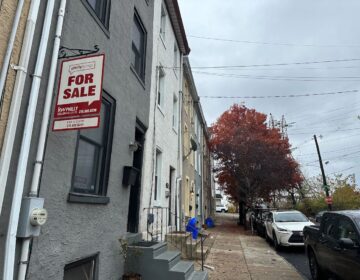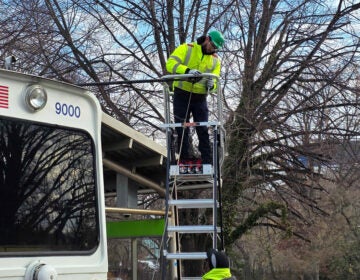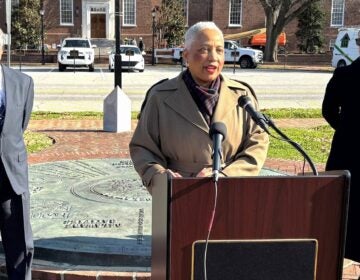Establishing principles of diversity and culture
Feb. 13
By Kellie Patrick
For PlanPhilly
A promenade winds along the Delaware of Philadelphian dreams, tying together places and spaces for everyone.
Children romp in playgrounds. The athletically inclined play hard in parks designed for activity while others soak up solar rays on lazy summer days. Restored old buildings show off their charm. New buildings come in a variety of sizes and those meant to be lived in are affordable to everyone. There are fishing piers, and natural areas. Spaces large and small host festivals and concerts attended by people of all age, ethnic, and socioeconomic groups.
These are some of the principle design elements that those attending a Monday night community forum hosted by PennPraxis believe would sustain, expand and celebrate diversity among the buildings, businesses and natural elements of the river – and the people who would be enticed to enjoy them.
“When they have the fireworks, a very diverse group comes,” noted Marsha Bacal, a 77-year-old retired publishing executive who lives in Society Hill. “You can bring a diverse group of people together if you give them a reason to do so.”
“If you give them a shared experience,” added Kevin Thomas, 52, a school police officer and fishing advocate from West Philadelphia.
“That’s what the river ought to become,” said Bacal.
Monday night’s meeting at St. Peter’s School in Society Hill was one in a year-long string designed to bring residents and experts together to forge a long-term plan for the 7-miles of the Delaware that stretch from Allegheny to Oregon Avenues.
Earlier sessions revealed five key values that Philadelphians hold for their waterfront; they want a safe, clean and open place that preserves the city’s history, sustains and expands the local economy and sustains and celebrates diversity among people, businesses, architecture and nature.
On Monday, about 100 participants were asked to record each other’s stories about what they had experienced along the Delaware – or, more often than not, what they would like to experience – that highlighted these values.
Those experiences, whether had here, in other cities or in a participant’s imagination, were then mined for actual elements that could be included in a riverfront plan.
During one portion of the meeting, participants were divided into five smaller groups of either 10 or 20 people. Each person had a question related to one of the values, and they used that question to prompt others in their group to tell them their stories.
Bacal and Thomas both had the diversity question.
Laura Spina, 37, the Planning Commission’s Center City community planner, asked James Loveman, a 31-year-old who lives in Washington Square West and works in real estate, to tell her about experiences at the waterfront or its neighborhoods that made him feel safe.
Loveman began: “Walking around Philadelphia, it’s the small spaces, the small streets – like that little park…”
“Three Bears Park?” Spina suggested.
“Yes,” said Loveman. “When broken down into small enough pieces, the difference between a street, a playground and a sidewalk are smaller. On Delaware Avenue, I just don’t get that feeling. I don’t feel safe. When I think about a safe feeling, it’s really the size of the buildings and streets.”
“Do you know of any waterfront city where that exists?” Spina asked.
“Amsterdam. I love Amsterdam. It has small buildings and small streets,” Loveman said. He mentioned New York City’s parks along the Hudson River, but quickly added, “I don’t think Philadelphia should try to become New York. It’s not Central Park along the river, but a dozen Three Bears Parks – or squares like in Amsterdam.”
A big goals of the PennPraxis process is to reconnect this city to its biggest waterway, and participants yesterday had been thinking about that, too.
When Barbara Seiple, a 65-year-old retired school nurse from Queen Village, asked Bryan McHale about diversity, McHale said the issue was really about bringing much of what already existed to the waterfront.
“The diversity of the waterfront is directly related to the diversity of neighborhoods,” said McHale, a 27-year-old IRS employee from Fox Chase. “This is a city of neighborhoods, of different groupings. If you walk through (the neighborhoods closest to) the seven miles, you pass through every ethnic, generational, and economic group in the city. If anything, the problem is the waterfront is so separated from the city main that the diversity doesn’t jump over.”
Loveman ended his story with a wish for waterfront transit. “I don’t think we’re going to have any of these things I really like if everybody has to drive down there.”
He was not the only participant to talk about what he didn’t want. And what many said they don’t want is something the state wants badly and has already approved: Riverfront casinos.
Rosanne Loesch, an attorney from Society Hill, believes the dreams she and others have for the river and their neighborhoods cannot come true with casinos in the mix. Many who are active in riverfront neighborhood associations have rallied together to fight the casinos, she said.
At the beginning of the session, Loesch asked PennPraxis executive director Harris Steinberg how the sessions could continue as they have when so many people opposed the casinos.
Steinberg replied that the riverfront planning project was separate from the casino issue, which is outside of its control. Casinos could well take up one portion of the waterfront, and so the long-range plan for the river must be able to encompass them, should that happen.
Harris Sokoloff, director of the Penn Project on Civic Engagement and one of Monday’s moderators, said that while the planning process is separate and those guiding it cannot take sides on the casino issue, participants can make their desires known when they establish goals for the waterfront. If it is clear that citizens’ goals coming out of these sessions do not mesh with casinos, that can be fodder for anti-casino activists, he said.
All of the design elements collected Monday will be added to those collected at a similar session to be held at 6 p.m. Feb. 20 at Furness High School, S. 3rd and Mifflin streets.
And all of the input will be used by a team of renowned designers, who will next month sketch out the first drawings of what the river might one day look like.
Kellie Patrick is a former Philadelphia Inquirer reporter who lives in and writes from Montgomery County.
WHYY is your source for fact-based, in-depth journalism and information. As a nonprofit organization, we rely on financial support from readers like you. Please give today.






